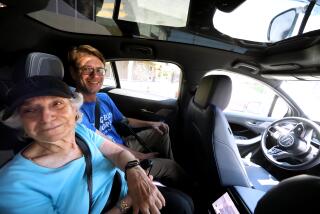Warning: Today’s Column Comes With No Instructions
Rapid advancement in technology nearly always means somebody is going to be left in the dust, unable to keep up with changes that seem to come hourly, but new research suggests it doesn’t have to be that way.
The ubiquitous automated teller machine is so easy to operate and so convenient that it has dramatically altered the way most of us do our banking. I haven’t seen the insides of a bank in months.
So it would seem likely that everybody would jump on this bandwagon, freeing them of the need to plan their day around their bank’s business hours. But researchers at the University of Georgia, the University of Michigan and Georgia Institute of Technology have found that a large segment of our society finds these contraptions fearsome, confusing and unusable.
Researchers surveyed 1,562 adults in a project that began in 1993 and found that 86% of those between the ages of 18 and 35 use automated teller machines. But only a third of those 65 and older use them.
The primary reason cited most often by seniors for why they have shied away from ATMs is so basic that it is troubling. They didn’t use them, they said, because they didn’t know how.
In that simple admission lies a warning that no industrial society can afford to ignore. What may seem simple to so many of us may be so difficult for others that they find themselves increasingly isolated from their own culture.
OK, so nobody has to use an ATM to get by, particularly retired folks who have the time to go to the bank during normal working hours. But that is beside the point.
Richard Sit, a doctoral student at Georgia Tech who has participated in the research, says the same people who refuse to use an ATM are also disinclined to use a videocassette recorder and would never attempt to run a personal computer, “despite a strong desire to do so.”
There may be some truth in the frequently stated claim that older people find it harder to master new technologies, but that’s only a small part of the story. The fact of the matter is that most people who get left behind are technologically disenfranchised by those of us who think all of this is so simple they shouldn’t need any help.
Wendy Rogers, associate professor of psychology at the University of Georgia, one of the leaders in the research project, says she was astonished when she asked banks about the training they offered their customers on the use of automated teller machines.
“They said: ‘Training? What training? It’s so easy to use,’ ” Rogers says.
Yet Rogers found that nearly 63% of the seniors she interviewed who had never used an ATM said they would gladly do so if they could get a little training, especially without having to stand in line while others behind them waited for them to get out of the way.
That would not solve all the problems. I did a little nonscientific survey myself, and all of the seniors I interviewed said they were more concerned about getting bonked over the head just as their money comes out than they were over using the machine correctly.
*
‘One thing you have to remember,” one 76-year-old told me, “is that when you get older, you feel so much more vulnerable.”
Yet there isn’t anything so difficult about operating an ATM or a VCR or even a personal computer that should bar so many people from using them. The problem is not in the machines. The problem is in the instructions, or lack of instructions, that come with them.
It all comes down to this: Either we can watch as more and more of our citizens drift further and further behind, or we can take the time and devote the resources needed to bridge the gaps.
Don’t help that little old lady cross the street. Show her how to use the ATM.
Lee Dye can be reached via e-mail at leedye@compuserve.com






